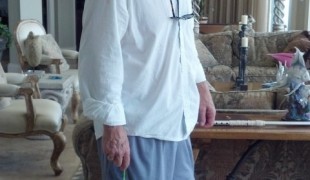- 17565
- 527
- 55
- 30
- 0
- Help Ukraine
About the solution
When she was 15 years old, Ruth Amos created the StairSteady as part of a school project. She was originally inspired to develop the StairSteady – a stair climbing device for the elderly or people with disabilities - for the father of one of her teachers. "It was initially for my teacher's father who'd had a stroke - we decided that we wanted to design something to help him because he'd been told to keep active but he wasn't able to", Ruth explains.
Contrary to other motorized stair climbing devices, like stair lifts, StairSteady is meant to help people with movement difficulties to stay active, working only as an aid, supporting the user while allowing them to remain active and independent. The device consist of a handrail that is fixed to the wall on either side of the staircase and a sliding handle that support the user while climbing up or down the stairs. The system contains a mechanism that allows the handle to slide when pushed but locks when weight is applied. This way, the user can strongly hold the hand with both hands apply force on the handle, using it as support to climb up the stairs but to prevent them from falling.
Ruth entered her invention for the Young Engineer for Britain competition and won first prize. Since then, she has created her own company and started comercializing the StairSteady, providing a new and cheaper offer for this market. "Our product will fit any width of stairs and it's also low-cost," she said.
Since its launch, the StairSteady has helped people with a wide range of needs, from people who suffer from stokes, multiple sclerosis, Parkinsons but also to help in short-term conditions, for people recovering from sports injuries or requiring rehabilitation.
Adapted from http://news.bbc.co.uk/2/hi/technology/7375486.stm
https://www.fortunamobility.com/stairsteady
https://newatlas.com/stairsteady-mobility-aid/13420/
More information: https://stairsteady.net/
这些解决方案不应包括使用药物,化学品或生物制品(包括食品);创伤性设备;冒犯性的,商业或内在危险的内容。该解决方案未经医学验证。请谨慎进行!如果您有任何疑问,请咨询健康专家。
DISCLAIMER: This story was written by someone who is not the author of the solution, therefore please be advised that, although it was written with the utmost respect for the innovation and the innovator, there can be some incorrect statements. If you find any errors please contact the patient Innovation team via info@patient-innovation.com
-
-
555
-
0
-
9036

Man creates device to help to put on socks, shoes and even trousers
Grip
(SELF)-CARE: DRESSING: Dressing independently.
BODY BALANCE: Maintaining body balance
STANDING UP: Standing up from a seated position
Knee Deformity
Assistive Daily Life Device (to help ADL)
Strategy/Tip
Muscle weakness
Limited range of motion
Muscle pain or stiffness
Reduced grip force (grip)
Loss of muscle coordination
Muscle cramps or spasms
Joint deformity
Joint redness or warmth
Swelling or inflammation
Difficulty bearing weight
Muscle twitching
Difficulty standing from a seated position
Difficulty getting up from the floor
Numbness or tingling in the extremities
Joint pain or swelling
Restoring mobility
Promoting self-management
Preserving Organ Function
Rehabilitating After Stroke
Managing Neurological Disorders
Recovering from Traumatic Injuries
Maintaining Balance and Mobility
Preventing (Vaccination, Protection, Falls, Research/Mapping)
Caregiving Support
Internal Medicine
Neurology
Orthopedics
Physical Medicine and Rehabilitation
Rheumatology
Sports Medicine
Vascular Surgery
United States
-
-
-
353
-
0
-
4318

Collaborator Pierluigi Mantovani creates Evolution Devices - solutions that aim to transform Multiple Sclerosis Management
CAREGIVING
BODY BALANCE: Maintaining body balance
STANDING UP: Standing up from a seated position
WALKING: Walking
Multiple Sclerosis
Assistive Daily Life Device (to help ADL)
Walking Aid (wheelchair/walker/crutches)
App (Including when connected with wearable)
AI algorithm
Body-Worn solutions (Clothing, accessories, shoes, sensors...)
Restoring mobility
Regaining sensory function
Managing pain
Promoting self-management
Preserving Organ Function
Managing Neurological Disorders
Maintaining Balance and Mobility
To improve Treatment/Therapy
Preventing (Vaccination, Protection, Falls, Research/Mapping)
Raise awareness
Caregiving Support
General and Family Medicine
Internal Medicine
Medical Genetics
Neurology
Physical Medicine and Rehabilitation
United States
-
-
-
715
-
0
-
10534

Assistive walking device
WALKING: Walking
WALKING WITH A WALKING AID: Walking with a walking aid
BODY BALANCE: Maintaining body balance
Body-Worn solutions (Clothing, accessories, shoes, sensors...)
App (Including when connected with wearable)
Assistive Daily Life Device (to help ADL)
Walking Aid (wheelchair/walker/crutches)
Loss of balance
Frequent falls
Restoring mobility
Regaining sensory function
Managing Neurological Disorders
Recovering from Traumatic Injuries
Maintaining Balance and Mobility
Preventing (Vaccination, Protection, Falls, Research/Mapping)
Neurology
Physical Medicine and Rehabilitation
Mobility issues
Solutions for Disabled people
United States
-
 zh
zh